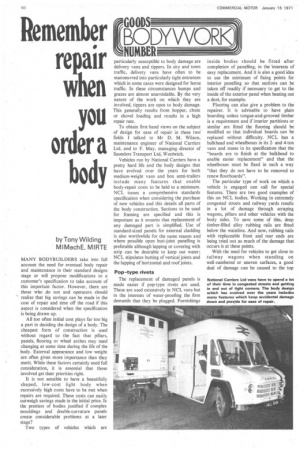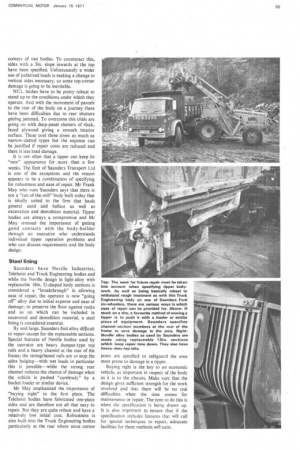Re member repair
Page 52

Page 57

If you've noticed an error in this article please click here to report it so we can fix it.
when
you order a body
MANY BODYBUILDERS take into full account the need for eventual body repair and maintenance in their standard designs stage or will propose modifications to a customer's specification to take account of this important factor. However, there are those who .do not and operators should \ realize that big savings can be made in the cost of repair and time off the road if this aspect is considered when the specification is being drawn up.
All too often initial cost plays far too big a part in deciding the design of a body. The cheapest form of construction is used without regard to the fact that pillars, panels, flooring or wheel arches may need changing at some time during the life of the body. External appearance and low weight are often given more importance than they merit. While these factors certainly need full consideration, it is essential that those involved get their priorities right.
It is not sensible to have a beautifully shaped, low-cost light body when excessively high costs have to be met when repairs are required. These costs can easily outweigh savings made in the initial price. Is the prettiest of bodies justified if complex mouldings and• double-curvature panels create considerable problems at a later stage?
Two types of vehicles which are particularly susceptible to body damage are delivery vans and tippers. In city and town traffic, delivery vans have often to be manoeuvred into particularly tight entrances which in some cases were designed for horse traffic. In these circumstances bumps and grazes are almost unavoidable. By the very nature of the work on which they are involved, tippers are open to body damage. This generally results from hopper, chute or shovel loading and results in a high repair rate.
To obtain first-hand views on the subject of design for ease of repair in these two fields I talked to Mr D. M. Wilson, maintenance engineer of National Carriers Ltd, and to F. May, managing director of Saunders Transport Ltd, Woolwich.
Vehicles run by National Carriers have a pretty hard life and the body designs that have evolved over the years for both medium-weight vans and box semi-trailers include many features that enable body-repair costs to be held to a minimum. NCL issues a comprehensive standards specification when considering the purchase of new vehicles and this details all parts of the body construction. Sections to be used for framing are specified and this is important as it ensures that replacement of any damaged part is simplified. Use of standard-sized panels for external cladding is also worthwhile for the same reason and where possible open butt-joint panelling is preferable although lapping or covering with strip can be desirable to keep out water; NCL stipulates butting of vertical joints and the lapping of horizontal and root joints.
Pop-type rivets The replacement of damaged panels is made easier if pop-type rivets are used. These are used extensively in NCL vans but in the interests of water-proofing the firm demands that they be plugged. Furnishings inside bodies should be fitted after completion of panelling, in the 'interests of easy replacement. And it is also a good idea to use the minimum of fixing points for interior panelling so that sections can be taken off readily if necessary to get to the inside of the exterior panel when beating out a dent, for example.
Flooring can also give a problem to the repairer. It is advisable to have plain boarding unless tongue-and-grooved timber is a requirement and if interior partitions or similar are fitted the flooring should be modified so that individual boards can be replaced without difficulty. NCL has a bulkhead and wheelboxes in its 2and 4-ton vans and states in its specification that the "boards are to finish at the bulkhead to enable easier replacement" and that the wheelboxes must be fixed in such a way "that they do not have to be removed to renew floorboards".
The particular type of work on which a vehicle is engaged can call for special features. There are two good examples of ' this on NCL bodies. Working in extremely congested streets and railway yards results in a lot of damage through scraping wagons, pillars and other vehicles with the body sides. To save some of this, deep timber-filled alloy rubbing rails are fitted below the waistline. And now, rubbing rails with replaceable front and rear ends are being tried out as much of the damage that occurs is at these points.
With the need for vehicles to get close to railway wagons when standing on well-cambered or uneven surfaces, a good deal of damage can be caused to the top corners of van bodies. To counteract this, sides with a 3in. slope inwards at the top have been specified. Unfortunately a wider use of palletized loads is making a change to vertical sides necessary, so some top-corner damage is going to be inevitable.
NCL bodies have to be pretty robust to stand up to the conditions under which they operate. And with the movement of parcels to the rear of the body on a journey there have been difficulties due to rear shutters getting jammed. To overcome this trials are going on with deep-panel shutters of thick, faced plywood giving a smooth interior surface. These cost three times as much as narrow-slatted types but the expense can be justified if repair costs are reduced and there is less load damage.
It is not often that a tipper can keep its "new" appearance for more than a few weeks. The fleet of Saunders Transport Ltd is one of the exceptions and the reason appears to be a combination of specifying for robustness and ease of repair. Mr Frank May who runs Saunders says that there is not a "run-of-the-mill" body built today that is ideally suited to the firm that hauls general sand and ballast as well as excavation and demolition material. Tipper bodies are always a compromise and Mr May stressed the importance of getting good contacts with the body-builder through an executive who understands individual tipper operation problems and who can discuss requirements and the body design.




































































































































